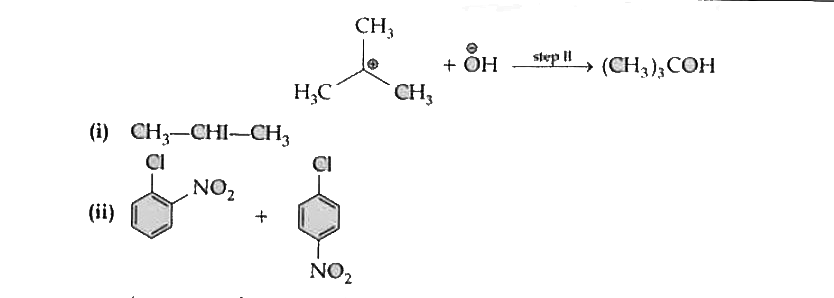InterviewSolution
Saved Bookmarks
| 1. |
(a) Explain S_(N)1 mechanism for the conversion of tertiary butyl bromide to tertiary butyl alcohol. (b) Complete the following reactions : (i) CH_(3) - CH = CH_(2) + HI rarr (ii) (iii) CH_(3)CH_(2)Br underset("Aq Ethanol")overset(AgCN)rarr |
Answer» Solution :In this step, polarised C Br bond UNDERGOES cleavage to produce a CARBOCATION and a bromide ion.  In this step, carbocation is attacked by nucleophile to form the product (formation of C-OH bond).  (b) (i) `CH_(3) - CHI - CH_(3)` (ii)  (iii) `CH_(3)CH_(2)NC` (a) Conversion of tertiary butyl bromide to tertiary butyl alcohol using `SN^(1)` mechanism occurs as FOLLOWS : Step - 1 : Formation of carbocation : `underset("(tertiary butyl bromide)")(CH_(3)-underset(CH_(3))underset(|)overset(CH_(3))overset(|)(C) - Br) overset("slow step")rarr underset("(carbocation)")(CH_(3)-underset(CH_(3))underset(|)overset(CH_(3))overset(|)(C^(+)))+Br^(-)` Step - 2: Fast step and formation of racemic mixture of product : `CH_(3)-underset(CH_(3))underset(|)overset(CH_(3))overset(|)(C^(+)) + underset("(Nucleohile)")(OH^(-)) overset("fast")rarr underset("(tertiary butyl alcohol)")(CH_(3)-underset(CH_(3))underset(|)overset(CH_(3))overset(|)(C)-OH)` (b) (i)This is an example of unimolecular nuclephile substitution reaction i.e. rate `prop` [substrate] (b) (i) `CH_(3)-CH=CH_(2) + HI rarr CH_(3)-underset(I)underset(|)(CH) - CH_(3)` (ii)  (iii) `CH_(3).CH_(2).Br underset("aq.thanol")overset(AgCN)rarr underset("(ETYL isocynaide)")(CH_(3).CH_(2).NC)+AgBr` |
|